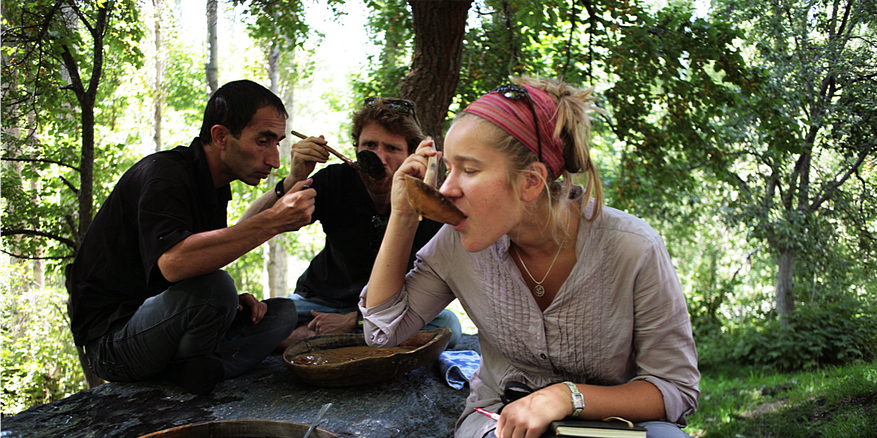Food sustains us; it gives us energy to live and feel alive. We love it; we hate it. It makes us laugh; it makes us cry (especially when slicing onions). Whatever the reason, food is highly emotive.
The emotive and evocative nature of food, can create a vessel of memory, breaking down mainstream and often ineffective development paradigms, and evoke new ideas. This experience comes from the high altitudes of the Pamir Mountains of Tajikistan and Afghanistan, where nomads, semi-nomadic people and farmers have been for centuries working together to create a landscape fit for living.
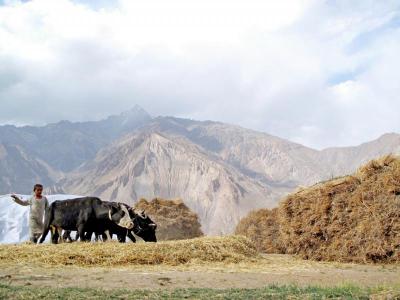
Boy grazing cattle in the Pamir Mountains. Photo courtesy of Jamila Haider.
Whatever romantic culinary fantasies come to your mind from a remote mountain landscape, brush them aside. This is food from a barren, isolated place. A place, that since the Buddhists traveled here, has been called, the Roof of the World.
The Russian scientist Nikolai Vavilov claimed Central Asia as a centre of diversity for apple, almond, flax, and a host of legumes, and the Pamirs, specifically, as the place of origin of rye. This diversity is visible to the trained eye when looking at the terraced mountain slopes, but is impossible to miss when one sits down to the Dashtakhon, or tablecloth, covered in dozens of varieties of apricots, cherries, nuts and various breads.
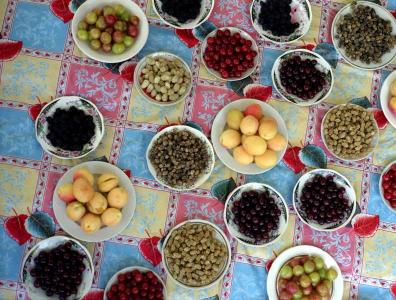 Dashtakhon, covered with plums, apricots, mulberries (both white and black) and cherries. Photo courtesy of Frederik van Oudenhoven.
Dashtakhon, covered with plums, apricots, mulberries (both white and black) and cherries. Photo courtesy of Frederik van Oudenhoven.
Yet, as a traveler in the Pamirs you will rarely be given any local dishes at all. Instead you will certainly eat Russian Borscht, Plov, a Central Asian rice dish vaguely reminiscent with Indian Pilau, and maybe French fries.
Only after two years of living in the region did I receive a delightful vegetarian noodle soup, called Osh, made with grains of vetch, wheat, rye, barley and fava bean. All the ingredients are traditionally grown on the same field, based on an ancient ritual in which grains are put in the hearth during the New Year, nawruz, and only the surviving grains are sowed. It is a nitrogen fixing method, important for arid and semi-arid soils of the Pamirs, and, allows for joint easy cultivation – all the grains can be milled together in a communal water mill.
After we, my friend and co-author of the book “With our hands: A celebration of food, and life, in the Afghan and Tajik Pamirs” Frederik van Oudenhoven and I, ate and complimented Osh, the grandmother who made it asked us to write down her recipe. Over seven local languages are spoken in the Pamirs, none of which are written. There exist very few written records of the Pamiri landscape and the culture that created it. And, so, we decided to write down not just grandmother’s recipe, but all of her friends, and of all the old people we could find. And so it quickly has become a book
As we travelled from valley to valley, we asked people to make us some of their traditional food, the food they cook for a family dinner every day. It is not that Pamiri people are not proud of their traditional food. But, it takes a long time to prepare; Osh, for example, requires hand-rolling a delicate dough into paper thin noodles. The lure of ready-made products from the market is great, and understandably so. But there seems also to be a feeling reminiscent from former Soviet times that ‘foreign is better.’ This is perpetrated by development organizations, who give away free improved seed varieties, encouraging the abandonment of traditional forms of agriculture.
The scarcity of local food prepared regularly in the Pamirs and the lack of quality market products from elsewhere, may be indicative of a food system, and the landscape and culture that goes with it, that is on the brink of transforming into something totally new. Our own fear is that the importance of these dishes and the role they play in maintaining diversity is generally under-recognised. One of the main aims of our work is to highlight that the local knowledge and culture that lies at the foundation of these recipes is incredibly valuable and should be documented and cherished.
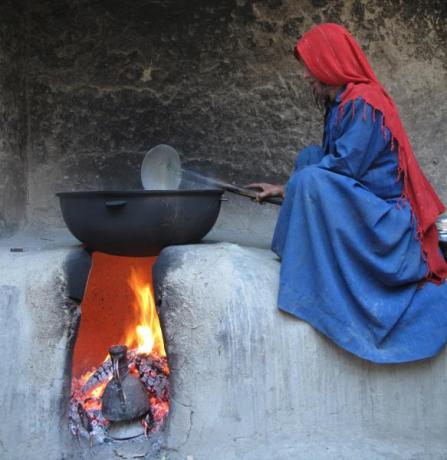 Woman cooking Osh in Jomarji Bolo, Afghanistan. Photo courtesy of Jamila Haider.
Woman cooking Osh in Jomarji Bolo, Afghanistan. Photo courtesy of Jamila Haider.
Shiroghan, for example, is a humble dish, eaten in the pastures everywhere in the Pamirs and offered during weddings as a symbol of purity and happiness. The recipe for this dish is only a simple line, and many would think hardly warrants further explanation: warm a bowl of milk and stir in some fresh butter so that it melts slowly. Add some salt to taste and eat with bread if it is available.
But more than a simple recipe, shiroghan is a story. Told by a teacher in Pastew, Northern Afghanistan it recounts the origins of the beautiful Lake Shewa in the Afghan Pamirs, around which many of these pastures are situated. The story follows:
At the bottom of what is now Lake Shewa, there was once a village. One evening, an old man came to the village and asked for some food. His cloths were ragged and people mocked him and threw stones at him. One woman, however, treated him kindly. She was poor and had only shiroghan to offer him. Thanking her, he told her to take her son and belongings and to seek refuge in a place high up on the mountain. She did as he had instructed her, and that night there was a large earthquake. Water appeared from the ground and flooded the village and its arrogant inhabitants. Later, the woman understood that the old man had been the holy Nasir Khusraw (a holy religious poet and scholar). Since that day, shiroghan has been considered a holy food.
This recipe can be considered a vessel of memory in that it brings to the fore the core values of Pamiri culture: since that time, hospitality, openness and sharing have constituted important attributes of the Pamiri people.
Take a moment to scan your culinary memory, are there certain smells that make you feel a certain way? For me, it is the starchy smell of polenta, cooking on my grandmother’s stove to make the Styrian dish stärtz, that reminds me of where I come from, it reminds me of what simple hard labour can achieve and what unconditional love is.
The personal and emotional connection we often feel with food gives voice to the otherwise powerless like women, herders, or farmers, and creates a rich social and ecological foundation about which to build development pathways.
One particular conversation we had with a relatively wealthy herder in the Wakhan corridor (recently converted to a National Park), represents the often circular effects of development projects. When asked what particular challenges he faces, he said that members of his family are sick more often than in the past, and that the elderly people suffer from high blood pressure, and heart disease.
When we asked him what he desires for his children’s future he replied that they should have better access to the market. However, it is not the rotting wheat from Kazakhstan and milk imported from Iran in tetra packs or margarine and eggs from China that he sees as power of the market. What he wanted was not just the access to the market, through roads and bridges, but power in the market, to be able to trade their goods for what he believes them to be worth.
This kind of reasoning, which we heard over and over when traveling from house to house, left us bewildered. As if our preconceived notions of development, even if they were not made explicit, had taken root in the minds of even the most remote pastoralists.
So, who is to say what is right and what is wrong to cultivate? At the same time, why shouldn’t Pamirs have access to markets and buy margarine instead of doing their own butter at 4,000m?
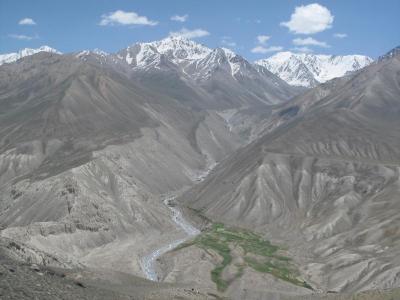 “The grass is always greener on the other side.” Looking up a typical Pamiri valley across the Amu Darya. Less than 3% of the land in the Pamirs is arable. This photo is of Afghanistan, taken in Tajikistan. Photo courtesy of Jamila Haider.
“The grass is always greener on the other side.” Looking up a typical Pamiri valley across the Amu Darya. Less than 3% of the land in the Pamirs is arable. This photo is of Afghanistan, taken in Tajikistan. Photo courtesy of Jamila Haider.
Life is not easy in this region. The Pamirs remain the poorest region of all Central Asian Republics and the Pamirs in Afghanistan have some of the highest opium addiction rates and maternal mortality figures in the world. All agriculture takes place above 2,000 m, the soils are dry and the slopes are steep. Working this land to make it productive is a labour of love. So, there are strong moral grounds for development interventions. However, these interventions need to be culturally appropriate and long term. They should not wipe out the diversity (both biological and cultural) that has been the source of a unique society for centuries.
The complex and often contradictory nature of development trajectories is perhaps nowhere better represented than by the contrast between Tajikistan and Afghanistan along the Pyanj Amu Darya River.
In most conventional ways of measuring development, the Tajik side of the Amu Darya is better off. They have paved roads and cars, tin roofs, electricity and schools in every village. Literacy rate for both women and men is above 99 percent. Most villages in Northern Afghanistan in the meantime are connected by donkey trails, there is no electricity aside from a few micro-hydro plants, and literacy rates are as low as 13 percent for women. But, when you ask about food, another story emerges.
“One important difference is that here, in Afghan Shugnan the land has always been owned by us, for many generations. This means that our traditions have become strong, since they had a long time to take root and develop. Our food, our economy, our clothes, all is better. We can sustain ourselves; we have autonomy over what we eat. People on the Tajik side have become very dependent on others. But on their side, of course, they have good roads and electricity. In that sense they are more advanced”, says a farmer in Afghan Shugnan.
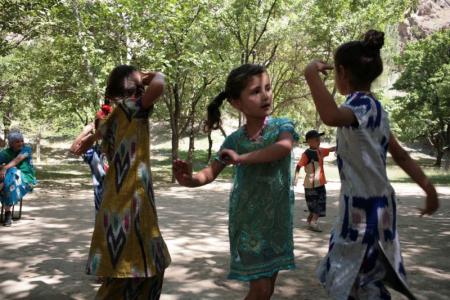 Tajik girls dancing. Photo courtesy of Jamila Haider.
Tajik girls dancing. Photo courtesy of Jamila Haider.
The examples from the neighboring Tajikistan and Afghanistan draw a complex and diverse picture of the region’s development and raise practical challenges and moral dilemmas for the actions to achieve future food security and sovereignty.
On one hand, it is quite obvious that the growing population of Pamirs is not likely to be food secure, relying merely on traditional production. An agronomist or a development practitioner may argue that the limits to production might be overcome through external solutions: improved seeds, new irrigation systems, or fertilizers to improve the nutrient poor soil.
On the other hand, such development solutions quite often take little or no regard for the human ingenuity that created this landscape in the first place. One sad example of this happened when a new ‘improved’ wheat variety was introduced to the Tajik Pamirs by development agencies in the late 1990s, and most farmers readily adopted this wheat to improve their yield. The new wheat molded when left to dry on the fields, and by that time the original seed had disappeared from the Tajik banks. A few Tajik farmers ha
